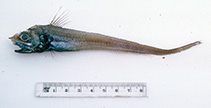| Family: |
Macrouridae (Grenadiers or rattails) |
| Max. size: |
18.2 cm TL (male/unsexed) |
| Environment: |
benthopelagic; marine; depth range 366 - 1000 m |
| Distribution: |
Western Central Pacific: South China Sea off Hong Kong, through Philippines and Indonesia, off northern Australia, to New Caledonia and New Zealand. |
| Diagnosis: |
Dorsal spines (total): 2-2. This species is distinguished by the following characters: pelvic rays usually 12-14 (elsewhere 11-13); total gill-rakers first arch (outer/inner) 17-22/23-28, second arch 22-28/22-26; no chin barbel; snout length 22-31% HL; orbit diameter 29-40% HL; suborbital width 10-14%HL, interorbital width 24-29%HL; most of the orbit, upper surface of snout, sides of head and trunk silvery or pale, ventral aspects of heed and trunk black; a prominent midlateral stripe of silvery (when fresh) or brownish (preserved) pigment running along trunk and tail (Ref. 97189). Additional distinguishing characteristics: pectoral fin rays 13-16; projecting snout, 20-26% HL; infraorbital width 11-16% HL; moderately long preopercular supporter, with obtuse angle at rear margin, 4-9% HL; ventral striae reaching to ½ distance from pelvic fin bases to periproct; otolith has moderately high predorsal lobe, with colliculi separated, closely placed across collum with a tendency to joining in large individuals, terminating at some distance from anterior and posterior rims of otolith; otolith length to height (OL:OH), 1.1-1.2; total colliculum length to pseudocolliculum length (TCL:PCL), 1.8-2.4 (Ref. 98298). |
| Biology: |
A benthic species found on the continental slope (Ref. 75154). Maximum depth from Ref. 106682. |
| IUCN Red List Status: |
Not Evaluated (N.E.) Ref. (130435)
|
| Threat to humans: |
harmless |
Source and more info: www.fishbase.org. For personal, classroom, and other internal use only. Not for publication.

